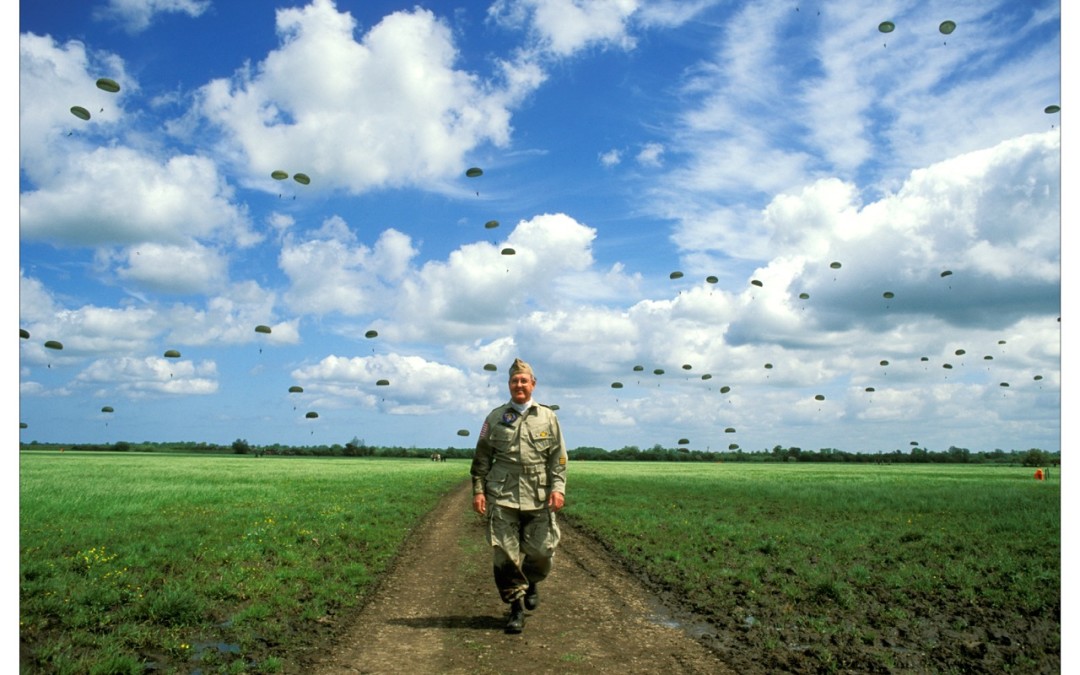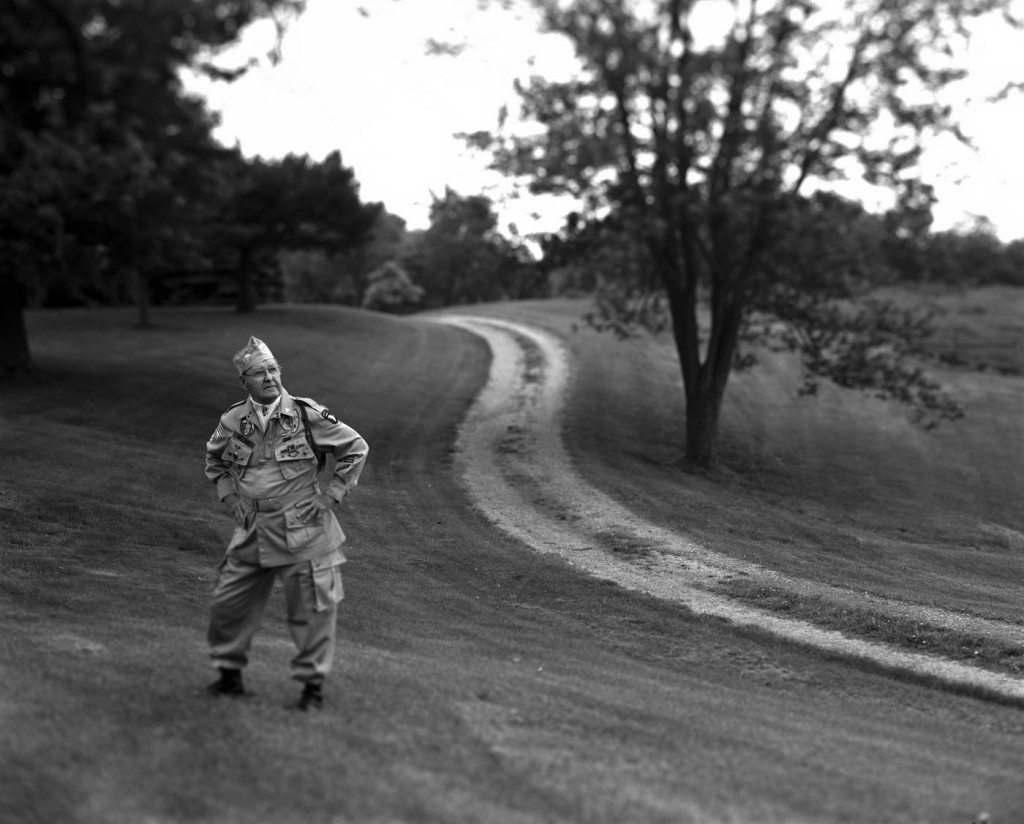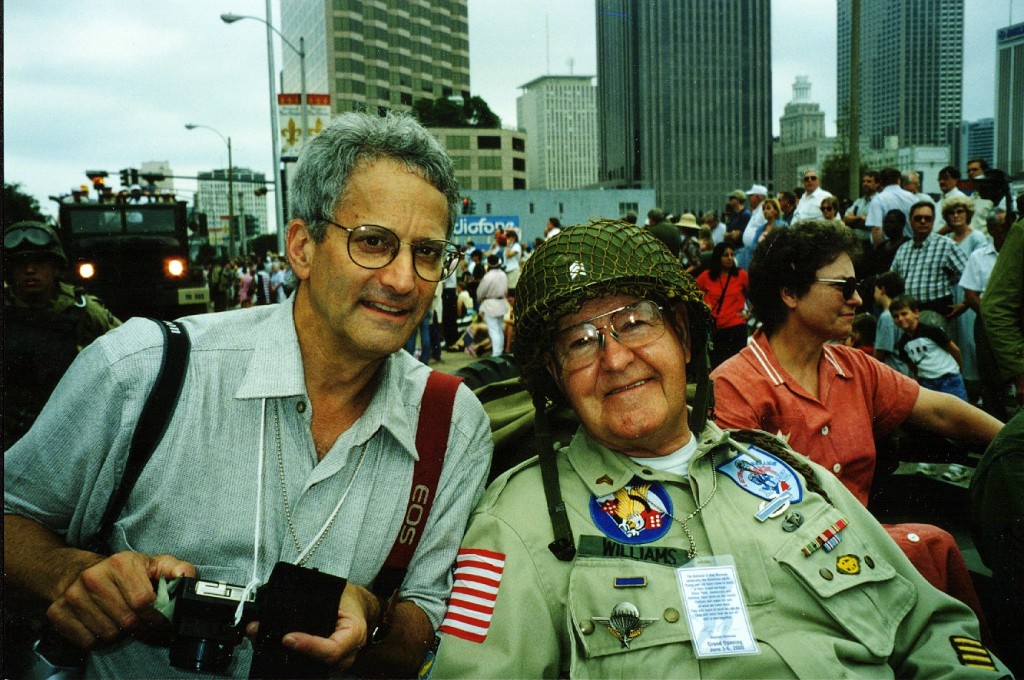Bob Williams: Ste. Mere Eglise, France. June 6, 1994 “My field of dreams….” ©2016 David Burnett/Contact/Facing Change
On the eve of New Year’s Eve, I received some sad but not unexpected news.
Robert L “Bob” Williams, 93, passed away today after a long illness, and a very full life. Bob grew up in Kentucky and Ohio, joined the Army early in the Second World War, and ended up as a paratrooper with the 101st Airborne Division. They were the guys who jumped into Normandy the night of June 5th, 1944, to secure the areas behind the beaches — where the landings would be the next morning — D-Day. As a kid of the ’50s, I knew a lot of history, and knew a great deal about World War II, though it was a long time before I figured out that those soldiers I’d heard of, and seen in the movies – “To Hell and Back,” “The Great Escape,” and “The Longest Day” – were also Chesley the pharmacist, Toke who sold lawn mowers, Howard at the clothing store, and Dick who I flew model planes with. They were the vets who had regained their lives as civilians, and in some cases shared their stories, but in most cases, you had to pry it out of them.
After the French Presidential elections of 1974, when I ended up working as Giscard d’Estaing’s personal campaign photographer, I found myself in Paris in early June, at the time of the 30th Anniversary of D-Day, and wanted to go the “debarqement” beaches in Normandy. With Tom Herman and Robert Wiener, Paris denizens of the time, we piled into a car and headed to Omaha Beach, unaware of what we would find. We spent the next few days meandering, meeting vets, seeing Omar Bradley (the last of the 5-star generals in his last appearance at a reunion) and early on the morning of June 6th, 1974, hired a local French fisherman to take us out into the fog, off shore a mile, where the landing craft had come. We wanted to try and see what they saw, though without the live fire and hellish welcome. We went to Ste. Mere Eglise, a small inland town where dozens of paratroopers fell before they even had a chance to fight. It was a moving experience, and without meaning to, it began what became an every 5 or 10 year effort to spend time with these wonderful veterans.
I returned in 1979, 1984, 1994, 2004, and 2014… As a TIME story noted in 2004, in the crappiest days of the Afghan and Iraq wars, “Why D-Day Matters” tried to explain the elemental greatness of what became Tom Brokaw’s “Greatest Generation,” and attempt to help us understand ourselves.
In early 1994 I learned that a number of 70+ year old World War II paratroopers wanted to jump again in honor of the 50th Anniversary of D-Day. Out of a perfectly good airplane. It was their way of saying how much it had all meant to them. The Pentagon, of course, was worried that there would be a headline like “8 D-Day Paratroopers Die In Parachute Accident…” Ergo, each trooper had to have 5 certified jumps (and none of them was under 70 years of age, with several way beyond…) that year to prove they wouldn’t be a liability to the festivities. So it became known that the vets would jump again around June 6, in a large farmers field not far from Ste. Mere Eglise. It would be quite the show.
Through a long and hilarious series of events to be recounted another time, I, along with Peter Turnley and David Turnley ended up far from the Press Pen, a gnarly fenced containment near the VIP area, about 1/2 mile from the ‘Drop Zone.’ No, the Turnleys and I were exactly where we weren’t supposed to be, and upon our arrival, an Air Force control officer gave us one of those “Media are not allowed here…” spiels, to which we responded that maybe we weren’t allowed, but we actually were there, and there was no place for us to go since the path to the Press Pen was directly opposite the drop zone. “We promise not to bite a single veteran…” was my own response. I just hate the officiousness which accompanies officious people. So, as he tried to inform us of what we could and couldn’t do, the sky filled with parachutes and cheers went up from the crowd all around.
Perhaps it was in tribute to the fact that most of those paratroopers had been, in 1944, dropped far from their intended drop zones, this time the same thing happened. Instead of hitting dead-on in the drop zone, they landed even further from the VIP area, on the far side of a berm, past the railroad tracks, in a field populated with healthy, milk producing Norman cattle. Instead of crisply sounding reports of their boots hitting solid ground, it was a series of mud induced squishes, landing up to their knees in the mud and assorted other bits. To quote one of the vets upon alighting, “Jeezussss Chrrist…I wait 50 years to jump in this place and I land in a pile of cowshit!!!”
After the last vet had landed, we started forming up with them, as they were expecting some other kind of fly over, and wanted to get the vets over to the VIP area and out of harm’s way. So across about 800′ of barren dirt I went behind a few vets, in front of several others. About 3/4 of the way across there was a small shed, used to store stuff for those Norman cattle. I ducked in, thinking, maybe there will be more. I waited a couple of minutes, and was broken from my revelry by the sound of C-141 cargo planes overhead, slowly heading to the northeast. All of a sudden, it became clear, another tribute jump was about to take place. This time it was 800+ active duty Paras from US bases in Germany, and they filled the sky with their camouflaged parachutes. It was as if they’d been sprayed across the horizon by the nozzle of a giant garden hose. They hung nearly motionless against a blue sky which might have been swirled by Van Gogh, slowly settling towards the earth. Then I looked down again, and there coming towards me, was a tall, strong looking 71 year old veteran.
I hopped out of the shed, and photographed a half dozen frames as he walked towards me, then turned and joined him for the last 100 yards to the VIP site, where I was, in short fashion, grabbed and tossed sans ceremony, into the Press Pen. From which, of course, you could see absolutely nothing. There was a lot of grumbling in French and English, though none of it from Peter, David or myself. One of the pissed off American photogs asked how the hell we’d been out there in the middle of the drop zone, and when we laughed and started to describe the completely accidental and lucky nature of that good fortune, he replied “Accident!? Accident?! Burnett and the Turnleys get the only picture – that’s no Accident!!” I realized that this is what makes for reputations, and just giggled under my breath. A few minutes later, with the “show over” we were all released, and figured out the next most important thing to do, which was getting film to Paris, and thence New York.
The following week TIME ran a double-page, full bleed, of my picture of the paratrooper, erect, proud, and mud up to his knees, surrounded by a backdrop of parachutes. Once the photo ran, I shortly thereafter heard from the guy in the picture; I never got his name at the time. He was Robert L Williams, 101st Airborne Division, and he couldn’t have been more pleased to be in my picture in TIME (and subsequently a lot of other publications.) There was a kind of unwritten rule that anyone whose picture you get into TIME or Newsweek as a full double page becomes a friend for life, and so it was with Bob. We would see each other now and then. I ran into him at the June 2000 opening of the D-Day Museum in New Orleans, later renamed the World War II Museum, and in 2004 when I needed D-Day vets for another TIME story, I called Bob and made a portrait of him at his Kentucky home. He signed some prints that I had made, “Robert L Williams 101 Abn My field of dreams…”
And it truly was. So much of his later life was formed by what he’d gone through in World War II. Once a year or so, I’d pick the phone up and give Bob a call, just to check up on him. In 2014 I asked if he’d made plans to head to Normandy for the 70th, and he said that no, he wouldn’t go this time, that sitting 9 hours in an airplane just didn’t agree with him anymore. We last spoke a year or so ago, and I could feel that the old soldier was slowing down. But there was never a hint of sadness or anything negative in what he had to say. I sent greetings to him on Facebook a few months ago, and heard back from his son that he was not well. Today, I read that his final battle is over, there will be no more combat for that wonderful paratrooper. And now that he’s gone, I think somewhere he’s probably flying around again as he did when he was just a young pup in a uniform. But this time, he doesn’t even need that perfectly good airplane. Best of luck, Trooper Bob. Godspeed.
–David Burnett, December 31, 2016



